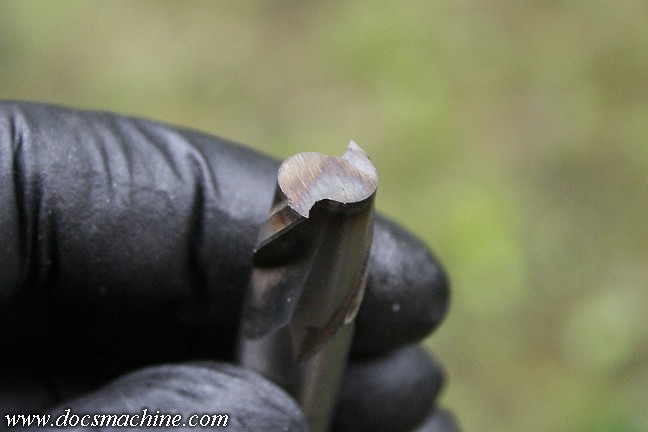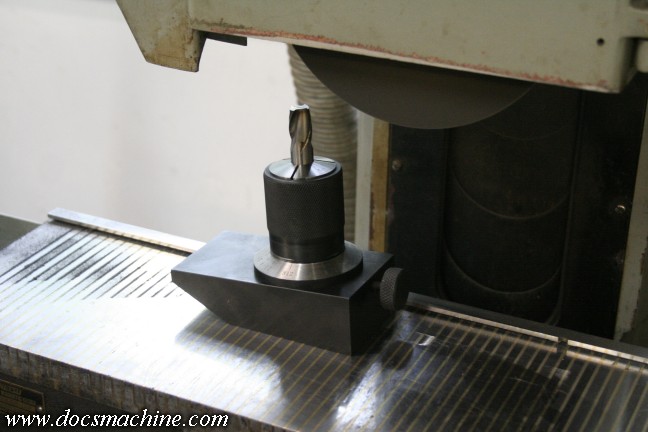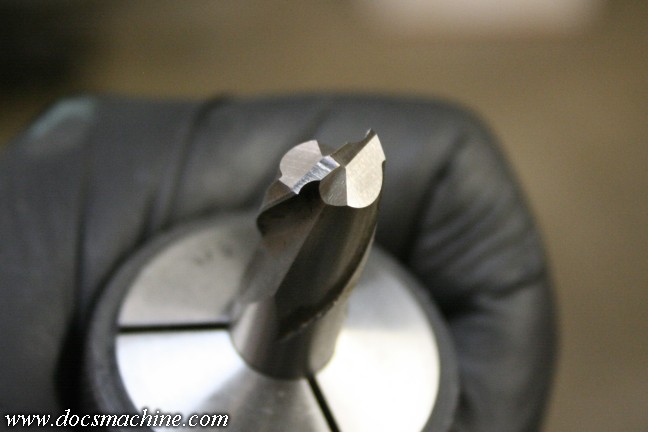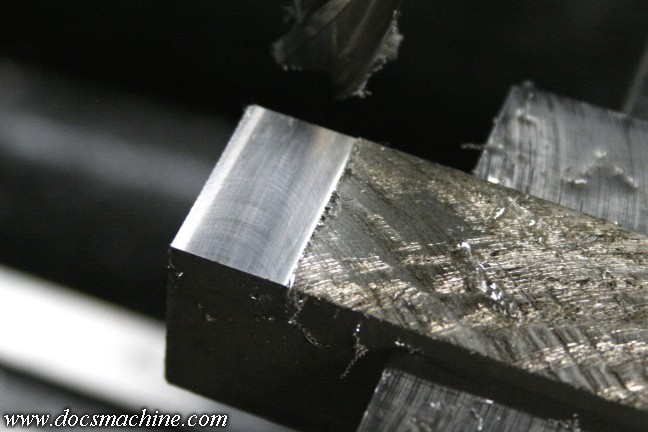machinist@lists.ibiblio.org
Subject: Machinist
List archive
- From: Lawrence London <lfljvenaura@gmail.com>
- To: machinist@lists.ibiblio.org
- Subject: [machinist] End Mill Sharpening Tutorial
- Date: Thu, 28 Aug 2014 21:07:59 -0400
http://www.practicalmachinist.com/vb/general/end-mill-sharpening-tutorial-281034/
Thread: End Mill Sharpening Tutorial
-
02-27-2014, 07:59 PM #1
- Join Date
- Oct 2008
- Location
- Central PA
- Posts
- 390
 End Mill Sharpening Tutorial
End Mill Sharpening Tutorial
We've periodically talked about how to sharpen end mills, but the information isn't in one place. I am not a professional sharpener, so there may be a better way to do this. Please add comments.
End Mill Sharpening
Look for the bright point of a dull edge and a bright line of dullness along the flute.


- Decide if only the end needs to be sharpened or whether the flutes also need to be sharpened.
- Put magic marker on the cutting edge & insert the end mill into the collet and sharpening fixture at 90º by eye.

Notice that there is a block between the rear fence and the grinding fixture to aid in relocating the fixture laterally when it is moved to change from the primary to secondary clearance angle.
- I used a 46H wheel. It cut well, but the edge rounded and needed to be redressed.
- Centering the end mill
You can touch the top edge of the end mill to the side of the stationary wheel and move in ½ the width of the end mill, or
You can eyeball the center and move the table inward to remove the little ridge that forms between the two end teeth if the wheel isn’t centered.


I hit the 5 photo limit, so the tutorial is continued in the next post
- Touch off with the wheel and mark that point on the downfe
-
02-27-2014, 08:06 PM #2
- Join Date
- Oct 2008
- Location
- Central PA
- Posts
- 390

- Grind off 0.010 in 0.001 increments and mark the downfeed wheel with a second mark.
- Raise the wheel head, rotate the end mill in the fixture and grind the 2nd side using the starting and ending marks on the downfeed wheel.
- Remove the round holder from the fixture and examine the end mill to see if the area of dullness has been completely ground away. If not, repeat grinding the primary angle.
- If the primary cutting land is too wide as in the photo below, the secondary angle needs to be reground

- When the fixture is tipped up onto the face for the secondary angle to be ground, the center of the end mill will move away from the previous center. Readjust the center by eye, and advance the cross feed about 0.050 more than the center of the end mill. It won’t hit the cutting face of the opposing lip if the end mill is oriented correctly in the collet.
- Touch off, mark the downfeed wheel as done previously, and grind in 0.001” increments.
- Watch that the secondary angle doesn’t impinge on the outer edge of the tooth. If the grind approaches the outer edge (i.e. not parallel to the tooth), stop and rotate the end mill slightly CCW in the collet and continue the grind.
- Grinding the gash.
- Some people do this free hand on a relatively hard wheel with a sharp edge.
- To grind this in the end mill fixture, turn the end mill Clockwise in the collet a small amount – maybe 5 minutes on the clock face to that there is less risk of grinding the outer edge of the tooth face.
- Put the round holder and end mill in the fixture with the cutting lips parallel to the longitudinal axis of the table and tilt the holder into the position for grinding the secondary angle. .

- Move the end mill away from the side of the grinding wheel by 0.010” to 0.020” to help in avoiding grinding into the cutting edge. After the gash is ground, if the end mill doesn’t look right, advance the cross feed 0.001” at a time and grind closer to the tooth face.
-


This part of the tutorial has covered only sharpening the end teeth. To sharpen the side flutes you need a different fixture such as the one(s) made by Weldon and others.
R.W. Lamparter Feb 27, 2014Last edited by RLamparter; 02-27-2014 at 09:29 PM. Reason: Picture in wrong place
-
02-28-2014, 11:31 PM #3
- Join Date
- Feb 2012
- Location
- The warm desert of Phoenix Arizona
- Posts
- 419

Thanks for the ideas.... I did not comment because I havent tried it yet.... I plan to, who knows when, it is on the to do list.
-
03-01-2014, 04:45 PM #4
- Join Date
- Sep 2010
- Location
- Guinea-Bissau, West Africa
- Posts
- 258

Looks doable! I must've missed the previous discussions you alluded to. Did you make that jig, or buy? Seems possible that one could even make a jig to clamp a normal 5c indexer vertical at the two appropriate angles? (I assume there's a standard primary and secondary angle, or do they very with endmill design?) Then that "5c indexer angle plate" arrangement could be held in the mag chuck. Or I suppose making a purpose built one wouldn't be impossible, but I've never tried to cut/grind a 5c collet holder either.

EDIT: My bad, they're all over online - searching for 5c endmill fixture. -
03-01-2014, 04:56 PM #5

Probably 80% of the time the endmill is only used one half the diameter up the flutes, or less. If so, just "slice" off the used end portion and re-point. If you are only milling and not plunging, you don't even have to get too excited about the end grind. In other words, treat it like a "break-off" knife.
The advantages are: The diameter stays the same. The geometry stays the same. It's a lot easier to do, and you don't have to have lessons in geometry.
Regards,
Stanley Dornfeld. -
03-01-2014, 05:19 PM #6
- Join Date
- Mar 2013
- Location
- Oshkosh, Wis. rauchle@ntd.net
- Posts
- 867
-
03-01-2014, 09:49 PM #7
- Join Date
- Oct 2008
- Location
- Central PA
- Posts
- 390

Here are photos of sharpening the primary angle.

and sharpening the secondary angle

The base is ground 3º off square for the primary angle, so that the center of the end mill is ground a little deeper than the periphery. The holder is at 90º to the base for the secondary sharpening angle. I have been photographing the various ends of unsharpened 2 and 4 flute end mills to record the geometry - mostly of the gashing. I may add some of those to the thread later as a reference. -
03-01-2014, 09:57 PM #8
-
03-02-2014, 07:46 AM #9
- Join Date
- Jan 2005
- Location
- Southcentral, AK
- Posts
- 1,491

Before:

Cheap $50 import grinding fixture:

And after:

How's it cut?

Fixture paid for itself the first day I had it.
Doc. -

disadvantage is one sharpen instead of a dozen or more. Can't argue about need the extra tackle, but why would anyone care about the dia. You cut to finish cut, measure the work then feed in what you need to - how does the diameter matter? -
03-02-2014, 03:02 PM #11
 Diameter change requires "program" change, somewhere. As you grind down the flute diameter, you compromize the radial rake angle the manufacturer ground into the tool. That's all.
Diameter change requires "program" change, somewhere. As you grind down the flute diameter, you compromize the radial rake angle the manufacturer ground into the tool. That's all.
If you trim the end and repoint, you have a (like new) endmill.
It's just another way to sharpen the tool.
Regards,
Stan-
- [machinist] End Mill Sharpening Tutorial, Lawrence London, 08/28/2014
Archive powered by MHonArc 2.6.24.
 Reply
Reply

